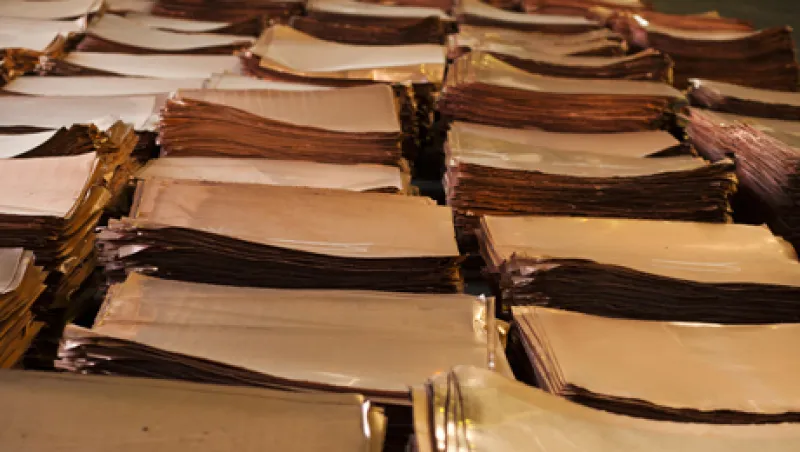Not all that glitters is gold. There’s another family of metals that are precious for their industrial uses, most notably, copper, for which demand will once again exceed supply this year for the third consecutive year, due largely to demand from China. The International Copper Study Group (ICSG), in its annual forecast issued in April, is projecting a global shortage of about 240,000 metric tons over the next twelve months.
And investors in the U.S. might soon have a new way of playing the copper market if several proposed ETFs — backed by the physical metal stored in warehouses — are approved by the SEC. The concept is not completely new. There are physical metal ETFs for the four precious metals — gold, silver, platinum, and palladium. But copper could be the first physical industrial metal in the ETF market in the U.S.
The industry is betting that J.P. Morgan Commodity ETF Services, which was the first to file for a physical copper ETF with the SEC in 2010, will also be the first to hit the market, possibly by June. Neither J.P. Morgan nor the NYSE will comment, but in early April, the NYSE made its own filing with the SEC, to list the new ETF on its Arca electronic trading platform, fueling speculation that SEC approval was near.
“This is a big move,” says Morningstar ETF analyst Abe Bailin in Chicago. “It’s not just another frivolous, ‘me too’ type of product. For the first time in the U.S. market, investors are going to be able to get exposure to physical copper, and that’s a ground-breaking thing,” he says, noting that it won’t be just accredited investors, but “Joe Six-Pack” as well.
BlackRock’s iShares also filed for a physical copper ETF with the SEC in September of 2011, and since it is in the quiet period, an iShares spokesperson said the firm would not comment on its proposed offering, either.
But perhaps most interestingly, ETF Securities, based in London, has filed with the SEC for a full suite of seven physical industrial metal ETFs in the U.S., including not just copper, but also aluminum, nickel, tin, lead, and zinc and a basket of all six. The firm already has experience with physical industrial metal ETFs in the U.K., where they launched the six individual metal ETFs in the latter part of 2010 and the first part of 2011, says Scott Thompson, the co-head of European sales for ETF Securities (U.K.) in London. In the U.K., the firm has yet to launch its physical basket ETF. That, he says, is the “last piece of the jigsaw,” where the firm is “still working on the logistics” of moving all the metals into a warehouse facility. In the U.K., ETF Securities also offers the more traditional futures-based industrial metal ETFs, including some index-based baskets, but “many investors prefer owning real assets,” he says.
That’s because the price isn’t subject to the supply and demand vagaries that sometimes afflict the futures market. (More on that in a second.)
Out of all the industrial metals, copper is the one that “most people focus on in connection with global GDP,” says John Hyland, the chief investment officer at the United States Commodity Funds of Alameda, California, which sponsors a futures-based copper ETF, the United States Copper Index (CPER). “If I told you that China’s GDP numbers had surprised on the upside, the Chinese might need lead for batteries, but most people trade copper,” he says. “Also, on the supply side, copper tends to be pretty constrained. You don’t have to worry about someone magically finding a new mine and doubling production” since copper is produced by just a few countries, notably Chile, he says.
The concept of warehousing copper to back up an investment product is somewhat controversial, says Wiktor Bielski, the London-based global head of Commodities Research at VTB Capital, the Russian investment bank. “Demand from China is very strong, with Chinese imports up more than 30 percent year over year, over the last five months,” he says. “There has been a significant drawdown of available copper inventory, so to use some of the remaining metal to back an investment product is just an inappropriate use in my view,” he says. In effect, Bielski fears that the ETFs will lead to hoarding.
Hyland says “the hoarding argument is illogical,” because investors who wanted that copper could simply buy shares in the ETF and redeem them for the physical copper. He notes that “you can do it for [the physically backed] gold, though no one ever does.” Hyland concedes that “maybe on the margin,” the physical copper ETFs “might push prices up a bit by making it more awkward to get copper, but you’d have to look at the prospectuses and see what rules they have about redemption [for the physical], and how it works.”
The main concern about warehousing copper is the cost of storage because unlike the precious metals, copper is big and bulky. “It costs roughly 1.5 percent of the current price of copper to store it each year, and when you add on the management fee and any insurance, it can get pretty expensive,” says Eric Dutram, the ETF strategist for Zacks Investment Research in Chicago. But, he adds, the counterpoint is that the returns on futures-based ETFs can be impacted negatively by “contango,” when the near-month futures are cheaper than those expiring further out into the future. That means that as the ETF “rolls” its expiring contracts, it has to sell low and buy at a higher price. (The opposite, which is favorable to investors, is called “backwardation.”)
ETF Securities says that at the moment, despite the costs of storage, its physical copper ETF is outperforming their futures-based copper ETF. In part, that’s because “there is only a modest difference between the cost of physical storage (around 1.6 percent per annum), and the most recent [futures] roll cost, which was around 1 percent annualized,” said Martin Arnold, the firm’s London-based head of research, in an email. The physical ETF has also been outperforming because of the difference between the cash settlement price on the London Metal Exchange (LME) versus futures prices, he said.
Arnold also notes that in recent months, copper prices have been rising because LME inventory levels are low. Currently, the LME has 256,275 tons of copper in inventory, a decline of 53 percent from the February 2010 high of 549,725, he said.
In a recent web-based presentation to investors, Arnold also noted that BREE, the Australian government’s Bureau of Resources and Energy Economics, “forecasts copper prices to average $8430 in 2012,” and predicts that copper prices will “strengthen by around 5 percent to $8830 per ton in 2013, reflecting the increasing tightness of the physical market.”
Copper came close to a high of $10,000 a ton in 2011 — once, in February, and later, in July, Arnold said in a follow-up email. But copper is also off its recent low of about $7,000 a ton in September 2011, he said.
It’s worth noting that the ICSG, in projecting its deficit for the next 12 months, also saw the possibility that the three-year long copper deficit could be reversed in 2013 because of “increased output from new and existing mines.” In its April report, it said that “based on initial projections, refined copper production could exceed demand by about 350,000 tons” in 2013. But it also said that “numerous factors,” ranging from possible “European Union sovereign debt issues,” to “political disturbances in the Middle East and North Africa,” to “production shortfalls owing to labor unrest, utility and capital shortages and technical factors create significant uncertainty.”






